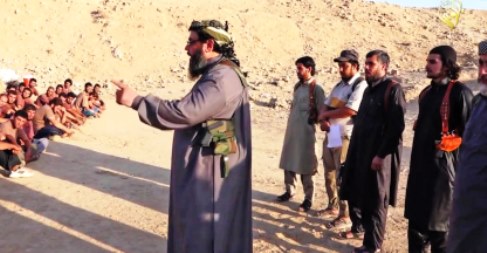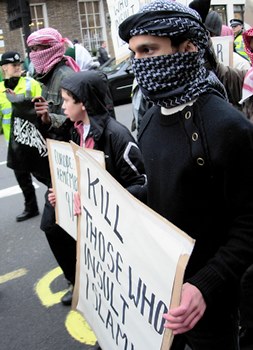
Oct 2014
Photo: Karl-Ludwig Poggemann
The fight against Islamic State is now a top-priority of the international community. Islamic State was seriously underestimated, not only by the US. It took the international community so long to acknowledge the threat of Islamic State and to confront them, that they now seem already rather well settled in their newly acquired territory.
One of the root causes of this is that Western governments are not aware enough that there is no such thing as a clear distinction between moderate and terrorist Islamist organizations, nor such a thing as a clear distinction between mainstream Islamic organizations and Islamist (or Islamic political) organizations. This lack of awareness is also a danger for their home policies regarding radical expressions of Islam.
Hesitation
The initial hesitation of the US government might well have had to do with the idea that backing “moderate” Islamists would do more good than fighting the “terrorists”. As a Gulf News Report (June 2014) wrote, “The President personally issued Presidential Study Directive 11 (PSD-11) in 2010, ordering an assessment of the Muslim Brotherhood and other “political Islamist” movements, including the ruling AKP in Turkey, ultimately concluding that the United States should shift from its longstanding policy of supporting “stability” in the Middle East and North Africa (that is, support for “stable regimes” even if they were authoritarian), to a policy of backing “moderate” Islamic political movements.”
The USA is not the only country which has cherished the idea that within Islamism (or political Islam) a dividing line can be drawn between moderate Islamist groups and terrorist groups. In this view, moderate Islamist groups can be encouraged to refrain from violence when they are offered alternative avenues of dissent that do not require a resort to violence in order to be heard. Admittedly, such a tactic might not cause terrorist groups to cease their bombing, but it might stem the tide of recruits joining their ranks.
In this line of thinking, the main explanation for Islamist activity is dissent, or difference of opinion, that is not channeled in the right way. Others talk about grievances as the drive of Islamism. Dissent or grievances are undoubtedly part of the picture, but confining the analysis of the drive of Islamism to these concepts seems far too restricted and misses an essential element. Indeed, it presupposes frustrations, and does not reflect the spiritual motives of many Islamists. Many of them might sincerely wish to serve the world by establishing such a Caliphate that will bring peace and abundance of blessings when all bow down before Allah.

Photo: CC by al-Furqan Media
The speech delivered by Abu Muhammad al-‘Adnani, the official spokesman of the Islamic State in Iraq and Sham (ISIS) reflects this view. Al-‘Adnani announced the group’s rebranding as the “Islamic State,” declaring itself a Caliphate and its leader, Abu Bakr al-Baghdadi, the Caliph Ibrahim in a speech entitled, “This is the Promise of Allah.” The opening of his speech says, “Praise be to Allah, the Mighty and Strong. And may peace and blessings be upon the one sent with the sword as a mercy to all creation.”
It is amazing how the tenor of this speech – combining a strong wish for supremacy with a conviction that the end-result is best for all if they submit – resembles the tenor of the top Muslim Brotherhood ideologue Yusuf al-Qaradawi’s vision document written for the European Brotherhood organizations considered as “moderate” Islamists.
(Qaradawi devotes a large section of his book to the presence of Muslim minorities in Western countries).
If Islamists sincerely foster a positive drive for submitting the world to Allah, the distinction between “moderate” and “terrorist” Islamism is not that relevant when thinking about strategies to protect the world against a phenomenon like Islamic State. In fact, they share the same agenda. This implies that no category of Islamism can be lured into an agenda other than submission of the world to Allah, although modalities may differ over location and time.
Lorenzo Vidino, Senior Fellow at the Center for Security Studies, ETH Zurich has written a report about “Organized Islam in Western Europe: an attempt to categorize and assess influence”.
Vidino states that “Over the past twenty years the number of Islamic religious organizations has significantly increased, a development stimulated by several factors. In the Muslim world, the decline of nationalism, commonly dated to the early 1970s, coincided with a return to various forms of Islamic piety. In Europe, first-, second-, and third-generation Muslim immigrants, struggling to adjust to life in the West, have also come to see Islam as providing cultural identity.”
Vidino represents Islamic organizations in Western Europe as a continuum: (a) “extreme secularists”; (b) non-religious organizations created by individuals of Muslim background; (c) “mainstream” religious organizations; (d) organizations and movements that are increasingly conservative in their outlook, yet not Islamist; (e) Islamist organizations. The Islamist (or Islamic political) organizations – as the most radical part of the continuum – are further subdivided into ‘participationists’, ‘non-violent rejectionists’ and ‘violent rejectionists’.
While no dividing line can reasonably be drawn within the Islamist part of the continuum, it is highly debatable if such a line can be drawn between this Islamist part at the one hand, and the center and center-right of the continuum at the other hand. According to Vidino, “the center of the continuum of European Muslim organizations is occupied by the large numbers of organizations that embrace a conservative interpretation of Islam – again, with important differences among them – but do not actively push for the introduction of Islamic customs or law in the public space.” Vidino adds, “Moving rightwards from the middle of the continuum, one can find organizations and movements that are increasingly conservative in their outlook, yet not Islamist… Yet on many issues their positions are identical – if not, in some cases, more conservative – to those of many Islamists. The lines along this and most sections of the continuum are inevitably blurred.”
Fragmentation
Vidino links his discussion of the Islamic continuum to the question of representativeness of organizations of Muslim communities in Western Europe. Vidino says: “Because of the Muslim community’s internal fragmentation and the widespread reluctance of individuals to affiliate, no one Muslim organization operating in Western Europe has succeeded in attracting anything close to a majority of the relevant Muslim population. It is therefore very difficult to assess the popularity of each organization or to determine what percentage of European Muslims in each country should be placed on what part of the above-mentioned continuum.”
Vidino’s report suggests three approaches that might provide at least some idea about the popularity of various Muslim organizations: governmental outreach approaches, voting patterns and popularity of ideas. Vidino calls governmental outreach approaches and voting patterns, despite their enormous intrinsic flaws, relatively objective standards by which to assess the popularity and influence of European Muslim organizations, while to measure the popularity of ideas is largely intangible. However, it is at this level that the Islamist part of the continuum bridges into the more mainstream Islamic organizations – through the participationist Islamist organizations such as the European Brotherhood organizations. n
According to Vidino, the participationist Islamist organizations “have had enormous success in exerting their power on Muslim communities – not through direct membership, which is generally quite limited, but through a diffuse cultural hegemony. Not all attendees of participationist Islamist organizations’ conferences will embrace their views, but some will. And there are no other Islamic organizations that have the means to organize events even remotely on the scale of participationist Islamist organizations. If a young Muslim or a potential convert aims to know more about Islam, he or she is more likely to have easy access to participationist Islamist publications (notably from the European Brotherhood affiliated organizations) than to those of any other Islamic group.”

Photo shows protests over a cartoon depicting the prophet Muhammad Feb 2006
Photo: CC by Virgorama
Vidino concludes that “While their membership has remained fairly small, participationist Islamist organizations have shown an enormous ability to monopolize the Islamic discourse, making their interpretation of Islam perhaps not yet mainstream, but at least the most readily available, and putting their ideological stamp on any Islam-related issue, be it strictly religious or more properly political. Concepts and positions introduced by participationist Islamist organizations have been absorbed, often almost subconsciously, by large segments of European Muslim populations, irrespective of their religious and political views.”
It follows that Western governments have to be aware that there is nor such thing as a clear distinction between moderate and terrorist Islamist organizations nor a clear distinction between mainstream Islamic organizations and Islamist (or Islamic political) organizations. In fighting Islamic State and preparing to tackle returning jihadis, as well as in preventing future jihadis from leaving their country, Western governments should not turn for ‘moral compensation’ to whatever non-terrorist organizations they know, believing they are radically different from the terrorist organizations.
Western governments should focus on certain key concepts that are commonplace throughout most of the Islamic continuum – shari’a, jihad and kafir – and clearly communicate what they accept and what they do not – throughout the whole continuum. Only then can a reasonable degree of co-existence among people be maintained and the basic features of multiculturalism in Western Europe, as well as in other democratic nations, secured. n
Frans Veerman, Director of World Watch Research of Open Doors International, a charity which works to support persecuted Christians around the world)
“Organized Islam in Western Europe: an attempt to categorize and assess influence”, Dr. Lorenzo Vidino, Senior Fellow at the Center for Security Studies, ETH Zurich and a Policy Adviser at the European Foundation for Democracy
n(Commissioned by the World Watch Research Unit, as above)
n
